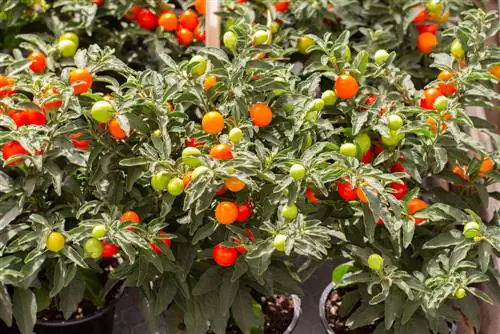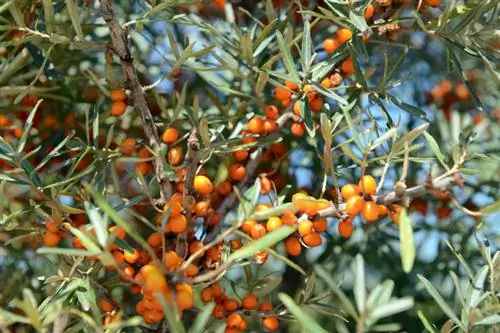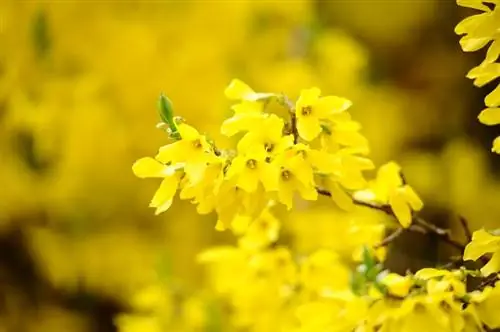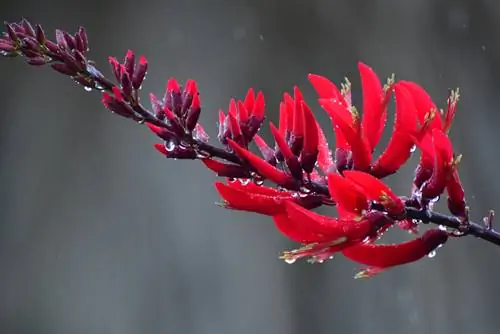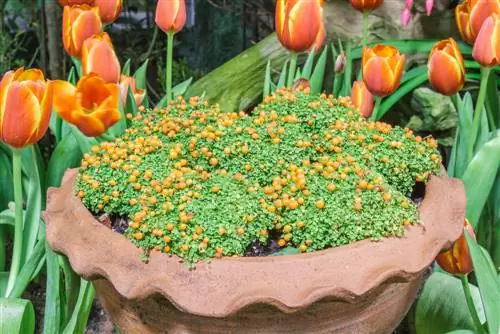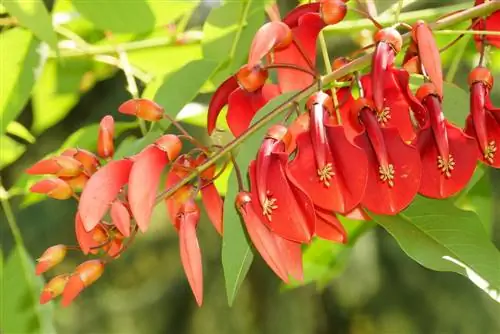- Author admin [email protected].
- Public 2023-12-16 16:46.
- Last modified 2025-01-23 11:22.
Read a commented coral bush profile here with information about winter hardiness, growth, leaves, flowers and fruit. Tangible tips on proper coral bush care and sowing Solanum pseudocapsicum.
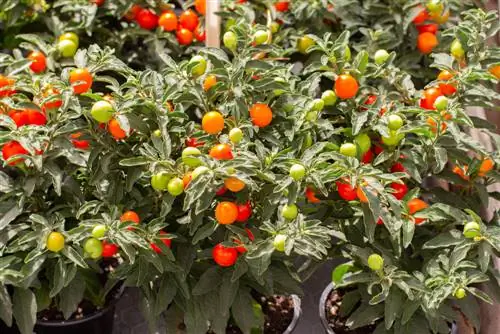
How do you properly care for a coral bush?
The coral bush (Solanum pseudocapsicum) is an evergreen shrub with elliptical leaves, inconspicuous white flowers and bright red berries. It is native to Central and South America and is not hardy. Care includes regular watering, fertilizing, repotting and cutting as well as frost-free, bright wintering.
Profile
- Scientific name: Solanum pseudocapsicum
- Family: Nightshade family (Solanaceae)
- Synonyms: coral tree, coral cherry
- Origin: Central and South America
- Growth type: shrub
- Growth height: 60 cm to 100 cm
- Leaf: elliptical, evergreen
- Flower: white, inconspicuous
- Fruit: Berry
- Toxicity: poisonous
- Winter hardiness: not hardy
- Use: houseplant, potted garden, summer balcony
Winter hardiness
The South American origin leaves no room for doubt: a coral bush (Solanum pseudocapsicum) is not hardy. Its subtropical and tropical home regions extend from Mexico through Brazil to Argentina. There, the coral tree inhabits sunny locations from lowlands to altitudes of 2,600 meters, where temperatures rarely fall below 10 degrees. Temperatures around freezing point reliably kill the exotic tree. The absolute minimum temperature is 6° Celsius.
Growth
The coral cherry compensates for its pronounced sensitivity to frost with a year-round decorative performance, crowned by a colorful display of fruit in the middle of the dark season. These key growth data explain why this distinctive ornamental tree has been a valued houseplant in Germany since the 16th century:
- Growth type: small evergreen shrub with delicate flowers and bright red berries.
- Growth habit: bushy, upright or partially prostrate.
- Growth height: 60 cm to 100 cm.
- Bark: initially greenish-brown and densely hairy, later golden-brown and glabrous.
- Ghorticulturally interesting properties: moderately difficult to care for, tolerates cutting, high ornamental value, poisonous fruits.
Video: The colorful world of Solanum pseudocapsicum as a houseplant
Leaf
With this decorative foliage dress, the coral tree stands out as a potted plant:
- Leaf shape: petiolate, narrow-elliptic to lanceolate, pointed at both leaf ends, leaf edges smooth, wavy or curled.
- Two size categories: large leaves 2.5 cm to 9 cm long, small leaves 0.9 to 3.5 cm long.
- Leaf color: dark green, bare above, sparsely to densely hairy underneath.
If the coral bush is allowed to overwinter properly, its leaves are evergreen. The plant sap contains a slightly toxic alkaloid that can cause itching, redness and rashes if it comes into contact with the skin.
Bloom
Solanum pseudocapsicum is a houseplant that doesn't reveal its exotic colors all at once. According to the motto “Modesty is an ornament,” coral bush flowers appear in summer with these characteristics:
- Inflorescence: stalked, consisting of 1 to 8 individual flowers.
- Single flower: five-petaled, star-shaped, white with yellow stamens.
- Flower Size: 1.5cm to 2.5cm in diameter.
- Flowering time: May/June to October/November.
- flower ecology: hermaphrodite
If the coral tree is cultivated as a houseplant all year round, you should gently shake the flowering plant repeatedly. This pollination method has proven successful for many nightshade plants with a roof over their heads, such as tomatoes, peppers or chili. Only pollinated flowers produce the desired fruits.
Fruit
Following the subtle blossom overture, the coral tree places its floral trump cards on the table with these fruits:
- Fruit type: spherical berry on a short, woody stem.
- Fruit color: depending on the degree of ripeness, green, yellow or bright orange-red.
- Seeds: flat kidney-shaped, pale yellow, 2-3 mm large, normal and light germinator
- Special feature: very poisonous
The coral bush owes its status as a poisonous plant to its berries. The most important toxin is the alkaloid solanocapsine. Eating just two coral cherries can cause serious poisoning in people and pets. Typical symptoms include severe nausea, painful vomiting, rapid heartbeat and circulatory collapse. The coral tree is not suitable for a family household with pets. As a non-toxic alternative from the nightshade family, cocktail tomato varieties are recommended, whose bright red mini fruits invite you to snack without worry.
Excursus
Coral bush coral tree differences
Attention, dear indoor gardeners: If you want to buy a coral bush or coral tree, you should take a close look. There is no differentiation between the two types of plants in the trade. The following table shows the sometimes serious differences between the tropical beauties:
| Coral bush | Coral tree | |
|---|---|---|
| Botanical name | Solanum pseudocapsicum | Erythrina crista-galli |
| Family | Solanaceae | Butterflies |
| Growth height as a container plant | 40-60 cm, rarely up to 100 cm | 150-300 cm |
| leaves | simple-elliptical | 3-part feathered |
| Flowers | inconspicuous | 40-50 cm long flower spikes |
| Flower color | white | bright scarlet |
| Flowering time | May to October | July to September |
| Fruits | bright orange-red berries | woody legumes |
| Toxicity | poisonous | non-toxic |
Planting a coral bush
In nurseries and garden centers you can buy a ready-to-plant coral bush from a price of 3.99 euros. Hobby gardeners favor planting after propagation by sowing. These planting tips are full of useful information:
Sowing
Germinating seeds (€3.00 on Amazon) are available from specialist retailers from €2. The optimal time window for sowing is from mid-February to early May. A flat bowl with a transparent lid is suitable as a seed container. Coconut soil is the ideal sowing substrate. Further important sowing tips in brief:
- Location: room temperature, bright, not full sun window seat.
- Germination time: 3 to 6 weeks at 22° to 25° Celsius (at least 20° Celsius).
- Sowing: Sow light germinators at a distance of 1 cm, sieve thinly, press down with wooden boards.
- Seed care: keep slightly moist, remove cover after germination, fertilize seedlings liquidly from a height of 7-10 cm, until repotting all shoots twice for one bushy growth.
With a height of 15 cm, the seedlings are repotted into individual pots and cared for like adult coral bushes.
Plants
Plant a coral bush in high-quality potting soil without peat with a pH value of 5.8 to 6.5. Mix in coconut soil as a peat substitute. Expanded clay is useful as an additive for a loose, permeable and structurally stable plant soil. Before you repot the coral tree into a beautiful flower pot, place the root ball and the cultivation or purchase container in soft water. A curved clay shard above the floor opening acts as a drainage so that irrigation water drains away quickly and the roots are not waterlogged.
Location
Under these conditions, a coral bush impresses with bright colors:
- Bright to sunny location without direct sunlight.
- Humidity and warm location with optimal temperatures of 18° to 25° Celsius.
- Ideally from May to September on the balcony.
If the coral tree is cultivated for several years, the winter location should be bright and frost-free at 8° to 10° Celsius. Before clearing out onto the balcony, a two-week hardening phase in a partially shaded location prevents leaf damage caused by sunburn.
Care for coral bushes
In this country, the coral tree is usually cultivated as an annual. With proper care and appropriate overwintering, the tropical plant can live up to ten years. These care tips summarize what really matters:
Pouring
- Water abundantly from spring to autumn to ensure even moisture in the pot ball.
- Watering more sparingly in winter (moisture meter in the substrate indicates the need for watering).
- Run low-lime water directly onto the slightly dried soil until the saucer fills up.
- Pour out the coaster after 10 to 20 minutes.
- Daily spraying during flowering promotes the formation of berries.
Fertilize
- Add an organic liquid fertilizer to the irrigation water every 3 to 4 weeks from March to October.
- Extra tip: liquid tomato fertilizer promotes fruit formation on the coral tree.
- Do not fertilize repotted coral bushes for 8 to 12 weeks.
Wintering
- Coral cherry bright and frost-free overwinter at 8° to 10° Celsius.
- Do not let the root ball dry out.
- Spray evergreen leaves weekly with filtered rainwater.
Repotting
- Do not throw away a coral bush with shriveled berries, but repot it in February.
- Shake off or rinse off old substrate.
- Cut off dead roots, cut back living roots if necessary.
Cutting
- After repotting, cut back all shoots by up to 2/3.
- Pnip off young shoot tips in spring for bushy branching.
- Important: put on gloves before pruning to protect yourself from the poisonous plant sap.
Propagation
Vegetative propagation through cuttings is possible. In contrast to uncomplicated sowing, there is usually a high failure rate.
Diseases, pests, care errors
Pests occasionally cause problems for the coral bush. Care errors are usually the cause when a Solanum pseudocapsicum weakens. The following table informs you about common malfunctions, typical causes and gives tips for effective countermeasures:
| malicious image | Cause | What to do? |
|---|---|---|
| Rolled leaf edges, undersides of leaves covered in insects | Aphids | shower, spray soap-spirit solution |
| Silvery leaf speckles, webs in the leaf axils | Spider mites | shower, spray daily with lime-free water |
| Brown leaves, leaf loss | Drought stress | Dip the root ball, water more frequently from now on |
| Floppy leaves and twigs, bad smell | Waterlogging | repotting, watering more sparingly |
| Yellow leaf veins, pale colors | irrigation water that is too hard | Use rainwater as irrigation water |
| Light brown leaf spots | Sunburn | Change location to partial shade |
| Yellow, wilted leaves in summer | Heat stress | Place the coral bush in a shaded area |
| Soft sheer leaf fabric | Cold shock | Observe minimum temperature of 6° Celsius |
Popular varieties
Two beautiful coral bush varieties bring color to creative living space greening:
- Variegatum: Variegated coral bush, cream-colored, yellow-green variegated foliage or yellow-spotted leaves with a white edge, bright red fruit decoration in winter.
- New Paterson: distinctive houseplant with narrow, elliptical leaves, white starry flowers and orange-red fruits, height 40 cm to 60 cm.
FAQ
Is a coral tree poisonous?
All nightshades are poisonous. The coral tree (Solanum pseudocapsicum) is no exception in this regard. Primarily the bright orange-red berries contain a high concentration of poison. Eating just two small coral cherries causes severe symptoms of poisoning. Children and pets who cannot resist the appetizing fruits are primarily at risk.
What water is used to water the coral cherry?
Please use predominantly filtered, collected rainwater as irrigation water. Alternatively, stale tap water at room temperature is suitable. With a simple trick you can reduce the lime content in hard tap water. Fill a cotton bag with 1 liter of peat. Hang the peat bag in a full 10 liter watering can for two to three days.
Is the coral bush hardy?
No, the coral bush (Solanum pseudocapsicum) is a nightshade plant from Central and South America. In its native regions, the shrub has not learned to assert itself against frosty cold. The minimum temperature is 6° Celsius, well above freezing point. For this reason, a coral bush is not hardy in Central Europe. If the winter is bright and frost-free, the coral cherry can live up to ten years as a houseplant.

